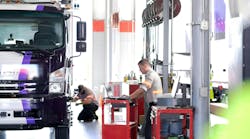LOUISVILLE, KY. Bendix Commercial Vehicle Systems sees a lot of new opportunities developing for safety system adoption by trucking fleets as a bevy of new regulations begin taking hold in the industry over the next several years.
New requirements that go into effect in August this year for tractor-trailers weighing 59,600 to 70,000 lbs. and travelling 60 mph significantly shorten the “stopping distance” requirement by 30%, from 355 ft. down to 250 ft. – and that’s boosted demand for air disc brakes among North American fleets to help comply with the new directive, according to Gary Ganaway, director of the foundation brake business for Bendix.
“In actuality for us, OEMs want a 10% factor of safety where stopping distance is concerned – a ‘cushion’ if you will,” he said during a press conference here at the 2011 Mid-America Trucking Show. “So we’ve actually had to bring that stopping distance down to 225 ft.”
As a result, air disc brakes are being spec’d in increasing numbers on the steer axle of Class 8 tractors to gain the stopping power required to meet the new standard – driving up industry-wide sales of air disc brakes 120% in 2009 over 2008 and a further 60% in 2010 over 2009, said Ganaway. To date, Bendix estimates 4% of today’s Class 8 fleet is now equipped with air disc brakes and the company said it is tripling production capacity to meet demand.
The newest safety opportunity is the desire for what’s been dubbed “always available” automatic braking systems, said Fred Andersky, Bendix’s marketing director-controls. That’s the key feature of the company’s new Wingman Advanced collision mitigation technology.
Wingman Advanced builds upon Bendix’s electronic stability program (ESP) technology platform. It is tied into a radar sensor mounted to the front of the vehicle to deliver both warnings and what Andersky called “active interventions” to help drivers mitigate rear-end collisions or at least help reduce their severity.
The system provides following distance and stationary object alerts which are always available – whether or not cruise control is engaged. The collision mitigation feature of Wingman Advanced provides additional interventions, whether or not cruise control is active, by alerting the driver and automatically applying the brakes to help decelerate the vehicle when the system senses a rear-end collision may be imminent, he said.
About two-thirds of the available braking power of the vehicle can be delivered through collision mitigation – compared to about one-third through adaptive cruise control with braking, Andersky said. The driver, however, still maintains control and can add additional braking or steering inputs to help avoid or minimize the collision situation, he stressed.
“Eventually, we hope to add a video component to this system in the near future,” Andersky added. “Radar is great at seeing through rain, fog, snow, darkness, etc., but is poor at detecting non-metallic objects. Adding video would allow the system to recognize stationary non-metallic obstacles, such as a deer in the road.”


